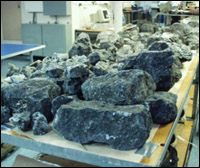Where we stand
In addition to her visit to the vent fields, what geochemist Deborah Kelley, of the University of Washington, said she would generally remember about the massif is "the diversity of the rock types."
"Compared to other places, I've seen weirder rocks here than I've ever seen anyplace else, and a greater number of them," said Kelley, one of the expedition's three co-principal investigators.

Fig. 3. Array of rocks retrieved during the cruise.
Standing in one of Atlantis's laboratory areas where the fruits of three weeks of collecting were being classified and stored for future study, she added: "Many of the rocks show the effects of remarkable deformation and interaction with seawater."
Reactions between hot rocks and seawater beneath spreading centers like the Mid-Atlantic Ridge can make their analysis both difficult and paradoxical for Kelley and her colleagues. Like a digital tape that has been played over to erase its original contents, a rock's original history can be lost when heat and seawater change its chemistry and texture. On the other hand, those changes can also tell the investigators something about where the rock has been.
New ocean crust is normally made along the Mid-Atlantic Ridge through sporadic volcanic activity, as hot melted rock rises up from Earth's underlying mantle to form "magma chambers" overlain by another rock type known as gabbro.
Within those magma chambers, less dense materials made of basalt separate and rise through cracks to erupt on the ocean floor as lava. Along the way, above the gabbro layer, they pass through conduits known as "dikes," another characteristic feature of undersea volcanic systems.
After 16 Alvin day dives between Nov. 11 and Dec. 7, and 13 Argo-II runs between Nov. 21 and Dec. 7, expedition scientists have noticed a pattern.
Basalts are mostly found on the north part of the massif, in the vicinity of where a "hanging wall" of ocean crust is hypothesized to have been undercut by a rising "footwall" further south.
On the mountain's south side - the hypothesized location for that footwall - uplifted mantle rocks called peridotites are common. And many of those shown signs of chemical alteration known as serpentinization. "Within peridotite, olivine is abundant," Kelley said. "Even at low temperatures, if olivine interacts with seawater it will alter. Most mantle rocks now exposed on the sea floor are 80 to 90 percent altered."

Fig. 4. The minerals olivine (left) and serpentine (right).
Once they're serpentinized, mantle rocks are much easier to deform and they become much less dense, occupying larger volumes than the peridotite minerals they're derived from, noted Kelley and Freuh-Green, another geochemist on the cruise from ETH in Zurich, Switzerland.
Indeed, one hypothesis behind the formation of this 12,000 foot mountain - an unusually tall one this close to the Mid-Atlantic Ridge - is that expanding serpentine minerals may have aided its uplift.
Among the many questions that will be explored in the coming months and years is why Alvin divers consistently found so few gabbro samples in places they were expected. "We found a few more, but they are still under represented from what I thought we would get," Kelley said. "Either we haven't found the places where the gabbros are, or they just aren't there."
The University of Wyoming's Barbara John noted another possible explanation may be "sampling bias." She noted that many promising rock faces were just too unbroken for Alvin to remove samples with its robotic arms. "We sampled cracked rocks," John noted.
If a drill ship came there in a followup project - a prospect that John and other expedition scientists openly lobbied for - "I wouldn't be surprised to find the ratio between gabbros and peridotites hugely changed," she added.
Meanwhile, gabbros that have been found are mostly in a deformed state, in fact more so than the peridotites. And that's another puzzle, Kelley added. "We'd expect the peridotites to be more deformed."
An additional surprise is the abundance of carbonates on the massif. Those are rocks that are neither of volcanic or deeper mantle origins. They can instead be made by living organisms, such as corals or shell-enclosed molluscs. Or they can be created by non-biological chemical precipitation - the Lost City vent field being just one kind of example.
Today's pages:
Wrapping up | Where we stand | A new kind of hydrothermal vent | One thing leads to the next

| 
|
|






